Sequel of the preceding post Cosmogenesis (6) : The Creation in the Renaissance
The Date of the Creation
None of the traditional myths gives a precise date for the Creation. The very idea of putting dates to the history of the world seems to have been foreign to the mentality of the ancients. For them the origin of the universe was simply a notion which helped them to understand the separation of reality into two regions: formless chaos and cosmic order. It was the Jewish/Christian preoccupation with time as a linear process which prompted the question: when was the Creation? From then on the greatest theologians (from Eusebius of Caesarea in the fourth century to James Ussher, Irish prelate and archbishop of Armagh, in the 17th century) and scientists (from Kepler to Newton) would attempt to provide the answer.
For centuries the only clues were to be found in the Bible, which was thought to be able at least to provide an upper limit to the age of the world. From studying the Bible, the vast majority of scholars put the date of the Creation at around 4000 BC, the most common method of calculation being to count the number of generations between Adam and Jesus. St Luke[i] and other commentators list 75 generations, which at approximately 50 years per generation make 4000 BC a plausible date. This reasoning was accepted until the 18th century, even though Ronsard ended his Hymn to the Sky of 1555 with the words: “Your beauty is such that I simply cannot believe / It is but four or five thousand years since your beginning.“
More precise estimates gradually appeared. According to the theologian and historian the Venerable Bede in the eighth century and Vincent de Beauvais in the 13th, the Creation took place in the spring.

In his historical treatise Annales Veteris Testamenti, a Prima Mundi Origine Deducti (Annals of the Old Testament, Traced Back to the Origin of the World) of 1650, James Ussher attempted to determine precisely the dates of the great biblical events by checking them against historical facts and astronomical phenomena. According to his calculations the first day of the Creation was 23rd October 4004 BC (beginning at midday) and Adam and Eve were expelled from the Garden of Eden on Monday 19th November, Noah’s Ark went aground on the summit of Mount Ararat on 5th May 1491 BC, and so on.
Similarly, in 1642, the Vice-Chancellor of Cambridge University, John Lightfoot, an eminent Hebrew scholar, stated that “heaven and earth, centre and circumference, were created all together, in the same instant” and that “man was created by the Trinity on October 23, 4004 BC at nine o’clock in the morning.”[ii]
These speculations were even incorporated into a new edition of the bible which appeared in 1701, but doubt was soon cast on them by a number of archaeological discoveries: it was found that there were already established civilisations in the great cities of Egypt in 4000 BC and similarly advanced societies existed in parts of Asia… The date of the Creation, which had to predate the appearance of the human race, would have to be put back.
The Fossil Problem
The hundred years after the death of Newton saw the birth of mechanism – a philosophical theory which explained all natural phenomena in terms of combinations of physical actions – and scientific rationalism – the belief in natural wisdom as opposed to wisdom resulting from divine revelation. The reconstruction of the past by purely rational methods was as yet too shaky a foundation on which to base a Creation date other than that suggested by the traditional interpretation of Genesis. Nevertheless, the traditionalists sensed a threat and closed ranks. Johann Jacob Scheuchzer, and encyclopaedist and professor of mathematics, had made a name for himself as a naturalist with his detailed descriptions of the flora and fauna, the geology and fossil remains of the Alps. In his Physica Sacra {The Physics of the Bible) he used his discovery of “diluvian” fossils to attempt to reconcile the Creation story – specifically the story of the Flood – with the contemporary science of geology. His “human witness of the Deluge” (Homo diluvii testis) was a fossilised giant lizard which he had found in 1726.
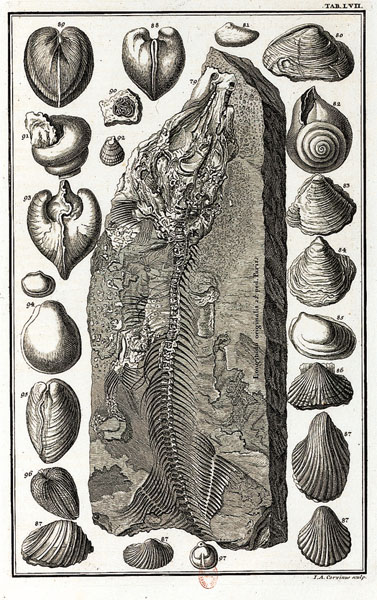
Johann Jacob Scheuchzer (1672-1733) published a number of books on the natural history of Switzerland and is regarded as one of the founders of sedimentary deposits having been laid in palaeontology and palaeobotany. A well known fossil collector and Director of the Natural History Museum in Zurich, Scheuchzer corresponded with many of Europe’s leading scientists.
His magnificently illustrated edition of the Bible was inspired by the diluvian interpretation of history – a theory supported by Scheuchzer’s friend John Woodward (1665-1728), whose work he had translated – according to which fossils were of organic origin, the waters of the Flood having dissolved rocks but not the shells and other remains of living organisms, and subsequent layers by the action of gravity.
Plate LVII is an illustration of a fossil Scheuchzer had discovered in 1726 and named “Homo diluvii testis”, on which he based his interpretation of the Bible.
This discovery seemed to prove that the human race had indeed been wiped out by the Flood, as described by the scriptures; according to Scheuchzer it also clarified a passage in Genesis which had always puzzled scholars: “There were giants in the earth in those days”[iii]. If there were giant lizards at the time of the Flood, all other creatures, including humans, must have been giants too! So Scheuchzer resolved to define the theological view of the Creation once and for all. Combining various texts from the scriptures with the speculations of the English clergyman and mathematician William Whiston (according to whom the Genesis story was an accurate historical account of the formation of the earth rather than of the universe as a whole[iv]) Scheuchzer elaborated the biblical image of “the fountains of the great deep” being “broken up” by the hand of God, imagining that He had grasped the earth and abruptly stopped its rotation, allowing fountains deep within it to release their waters, which had surged onto the land, causing the Great Flood.
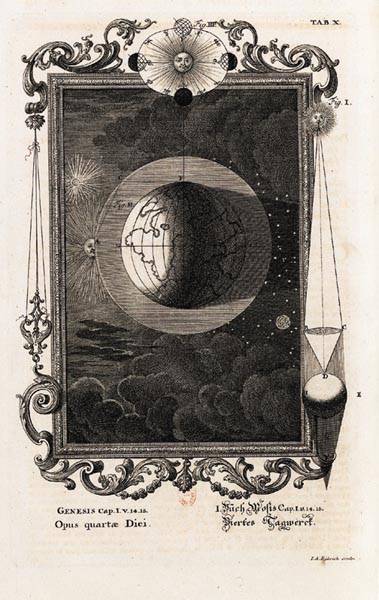
Johann Jacob Scheuchzer, Physica Sacra, Amsterdam 1732.
The Age of the Earth
The first scholars seriously to question the diluvian theory were the French archaeologist Benoît de Maillet and his compatriot, the naturalist Georges Louis Leclerc, comte de Buffon. In his Telliamed, which was originally published secretly, Maillet anticipated Darwin by 100 years in proposing that the world had evolved rather than been created in its final form and particularly in imagining that life had originated in the sea and that the earth was several million years old. Buffon, in his Théorie de la Terre (Theory of the Earth) of 1749, used the results of physical experiments as evidence of the age of the earth: he heated cannonballs until they were red hot, then measured the time they took to cool and concluded that the earth must be 74,832 years old.
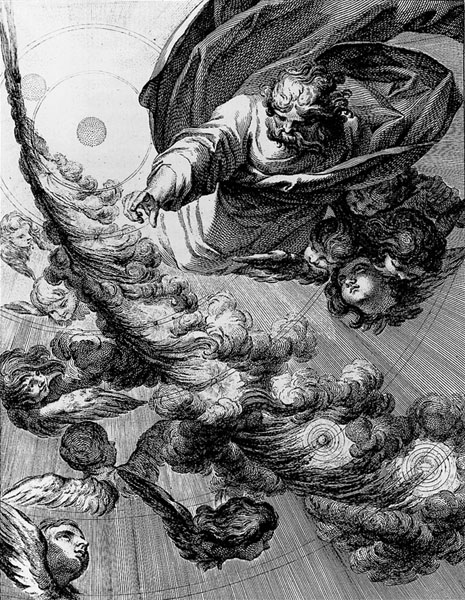
Buffon’s Natural History includes a “Proof of the Theory of the Earth” in which the author examines how the planets might have formed. Buffon begins by summarizing the theories proposed by the Englishmen Whiston, Burnet and Woodward and goes on to put forward his own hypothesis: based on his experiments with cannonballs it consists of a table summarizing the “beginning, end and duration of the existence of organized nature on each planet”.
Buffon’s sole intention was to express basic geological truths but the University of the Sorbonne forced him to publish a retraction in the most humiliating terms which ended with these words: “I renounce everything in my book that concerns the formation of the Earth, and generally everything that might contradict the story of Moses.”
Georges Louis Leclerc, comte de Buffon, “Théorie de la Terre”, in Histoire naturelle, Paris, 1749
During the 19th century the age of the earth, and of the solar system in general, was progressively increased as a result of discoveries in the new science of thermodynamics as well as in astronomy, geology and palaeontology. Previously the human race had been assumed to be as old as the earth, which had been created for man to live in. From now on it was recognized that, in relation to the age of the earth, the whole of human history was like the blink of an eye in an hour and it became increasingly difficult to believe that humanity was the raison d’être of the earth and the crowning achievement of God’s Creation.
Today big bang theory tells us the “age” of the universe – more exactly the duration of cosmic evolution – which is the length of time since the end of the Planck era, 13.8 billion years. This is calculated by measuring the rate of expansion of the universe, in other words the speed at which galaxies are moving away from each other. This number conforms to the age of the oldest recorded objects (stars and star clusters) in the universe, which has been measured independently[v].
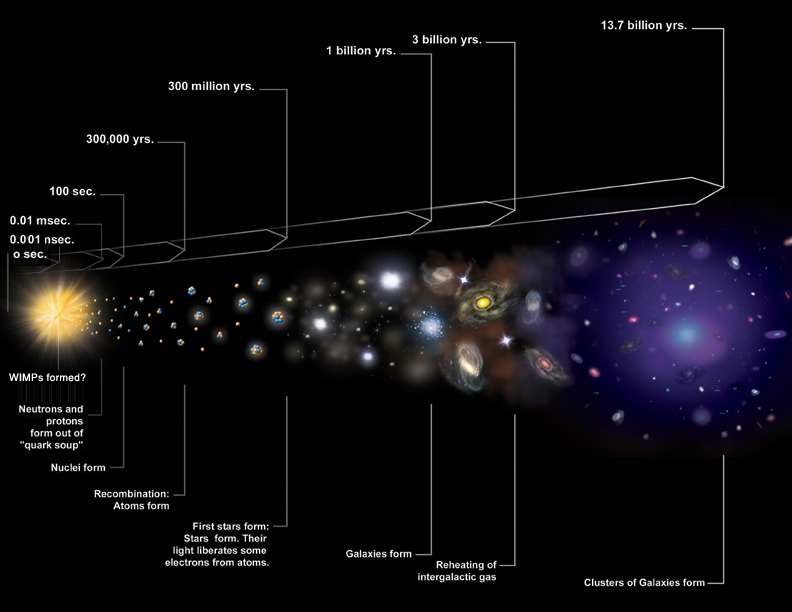 Now the exact age of the universe is known, the chronology of its evolution (decoupling of fundamental forces, appearance of elementary particles, star formation, etc.) is also firmly established, in some cases with mind-boggling accuracy. At the incredibly high temperatures immediately after the big bang things happened very quickly and almost as many changes took place in the first millionth of a second after the Planck era as took place in the next billion years. A few million years here or there in the life of a star is therefore less significant than a few billionths of a second in the life of an elementary particle… .
Now the exact age of the universe is known, the chronology of its evolution (decoupling of fundamental forces, appearance of elementary particles, star formation, etc.) is also firmly established, in some cases with mind-boggling accuracy. At the incredibly high temperatures immediately after the big bang things happened very quickly and almost as many changes took place in the first millionth of a second after the Planck era as took place in the next billion years. A few million years here or there in the life of a star is therefore less significant than a few billionths of a second in the life of an elementary particle… .
References
[i] Luke, III, 23-38.
[ii] Quoted by Andrew D. White, A History of the Warfare of Science with Theology in Christendom, Arco, 1955, p.9.
[iii] Genesis, VI, 4.
[iv] William Whiston, A New Theory of the Earth, London, 1708.
[v] Recent observations have put an end to controversy over the exact age of these objects.
****************************************************************
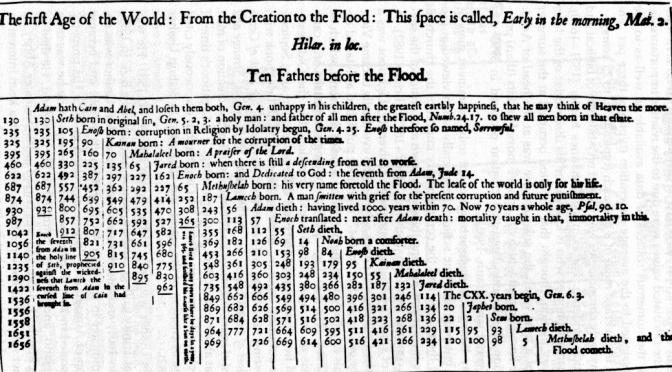
Bonjour m. Luminet. Il y a beaucoup d’informations. Réaliser cela demande une patience à tte épreuve. J’aimerais que vs développiez en profondeur un thème pr ns mener à votre science, à ce qui motive aussi votre peinture, votre écriture, toute cette vie vécue + que scientifique, ancrée ds le quotidien. Établir un lien. Un filon qui mène la rivière au fleuve, puis à la mer. Avoir un genre à vs, + que les info, tiens c’est Luminet, l’homme.La majorité vs attend, car cette pensée si riche ns intéresse.Vs déplacez les foules, vs saurez ns donner ce plus.
Je pense avoir fait cela dans mon livre “Illuminations , cosmos et esthétique”. Merci de me suivre.
M. Luminet,
Quelle intelligence rafraîchissante que la vôtre! C’est nous qui vous remercions. Je suis subjuguée…